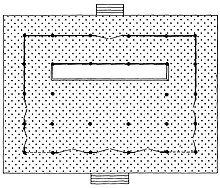Akishino-dera
The Akishino-dera ( Japanese 秋 篠 寺 ) is a temple that does not belong to any established school of Buddhism. It is located on the western edge of the city of Nara in the Akishino district.
history
The construction of the Akishini-dera was started at the request of Emperor Kōnin at the end of the Nara period in 776 and is said to have been completed around 794, when the capital was moved to Kyoto under Emperor Kammu . But there is also evidence that the temple was built as a prayer temple of the wealthy Akishino clan. However, the history of its origins cannot be precisely clarified with the existing documents.
Originally the temple belonged to the Hosso direction of Buddhism, in the Heian period it changed to Shingon , and flourished as a temple of this direction. In the Meiji period , the temple joined the Jōdo direction , currently it does not belong to any established direction.
The attachment
The original temple complex was lost to the end of the Heian period during armed conflicts due to a fire, with the exception of the teaching hall ( 講堂 , Kōdō) and a few other buildings.
In the Kamakura period the temple recovered, but with the violent separation of Buddhism and Shintoism, the "Haibutsu Kishaku" ( 廃 仏 毀 釈 ) at the beginning of the Meiji period, most of the buildings were lost again. After all, if you enter the extensive temple area through the south gate, you can see the foundations of the east pagoda. And the spread of broken roof tiles gives an idea of the size of the former temple.
The main hall ( Hondō ) has a floor area of 5 × 4 Ken , here 17.18 × 11.85 m (width × depth). It is covered with a hipped roof and has a tamped ground. Originally it was the teaching hall, which was then set up as the main hall in the Kamakura period. It is the only surviving building from the Nara period and a national treasure .
Treasures of the temple
The main cult figure of the temple is a seated Yakushi-nyorai from the Muromachi period . He is flanked by the Bodhisattva of sunlight ( 日光 菩薩 , Nikkō-bosatsu ) and moonlight ( 月光 菩薩 , Gekkō-bosatsu ). All three figures are registered as an important cultural asset .
Another important figure is the holy Gigei-ten (伎芸 天 ). The head with lacquer comes from the middle Nara period, the figure itself from the Kamakura period. The situation is similar with another figure, the Taishaku-ten ( 帝 釈 峡 ). These two figures are also important cultural assets.
There are a number of other figures in the main hall, including the Twelve Heavenly Generals . A number of important cultural assets of the temple are kept in the Kyōto National Museum.
literature
- Nara-ken kotogakko-kyoka token kenkyu-kyokai rekishi bukai (Ed.): Akishino-dera . In: Nara-ken no rekishi sampo (jo). Yamakawa Shuppan, 2010. ISBN 978-4-634-24629-4 .
Web links
Coordinates: 34 ° 42 ′ 13 " N , 135 ° 46 ′ 34.4" E

